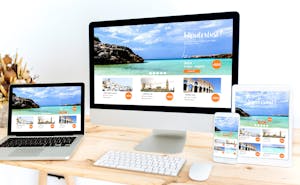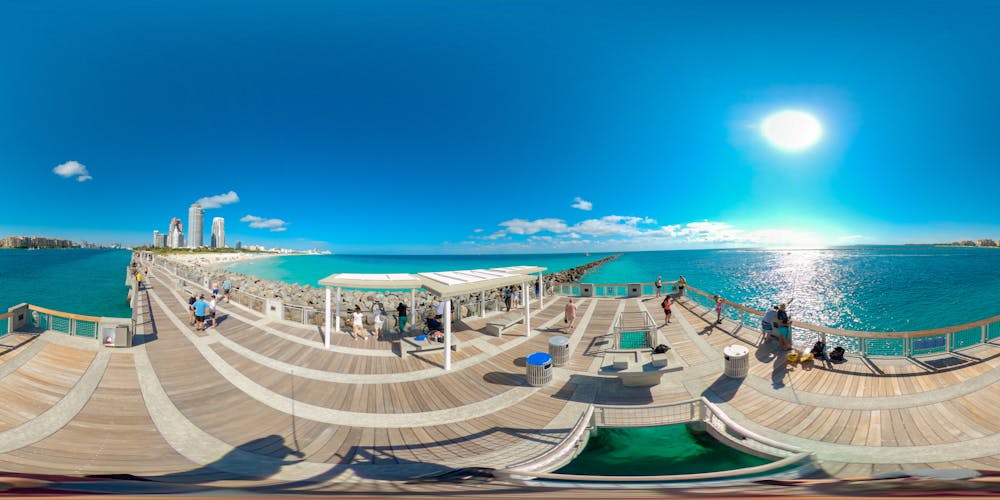- 7 minute read
- Digital Marketing
- Virtual Experiences
Intermediate
Spark is headed to the Big Easy! Join us in New Orleans October 13-15. Registration opens soon!

While the global coronavirus (COVID-19) pandemic has forced many tour operators to temporarily close down, it’s more important than ever to think about new ways to generate business. Whether that means promoting gift cards for your customers to use at a later date or taking the time to improve your email marketing strategy during a crisis, it’s always possible to continue to move forward, even if you’ve had to temporarily suspend your normal operations.
It’s natural to worry about what will happen if you can no longer run your tours and activities, but you may be surprised to learn that you can still offer versions of your activities that people can participate in from the comfort of their homes. Inspired by news stories like ones about the Paris Catacombs offering a virtual tour and many other museums around the world providing access to their art online, you too can explore running virtual tours or live classes during this pandemic. These alternatives may be able to generate some extra revenue right now while also acting as a tool to promote your tours and activities so that people will be excited to visit you in person when it’s safe to travel again.
What’s even more exciting is that your virtual tour or activity doesn’t have to end once business gets back to normal! Your new virtual experience can remain something you offer as a supplement to your traditional tour, as a way for someone who is unable to travel to your physical location or simply as creative and stand-out marketing material.
This guide will cover several ways to offer your activities in an online setting and discuss how to make this concept work for your business.

A virtual tour might mean one thing in the context of your business and something entirely different for another tour company. For example, a business that runs sightseeing trips might create a 360-degree tour that offers a look at one of their popular tour routes, while a cooking class business could host live classes online.
Overall, the virtual experience is meant to show off your business to people who would have liked to visit you but were unable to because of travel cancellations. It’s also a form of entertainment for people who are currently stuck at home looking for unique things to do. Millions of people are searching for interesting online content during this period, so you might even reach a new audience with your offerings — and those viewers could turn into future in-person bookers.
Now is the time to get creative about how you can adapt your tour or activity into an online experience. Here are a few suggestions and popular types of virtual experiences to help you get started.
The possibilities here are endless, even if your tours don’t usually take the form of a class or seminar. A phone or computer with a camera and WiFi are all you need to get started. Using an online video tool (more on these later), it’s easy to share a class or activity with guests.
 Cooking classes:
Cooking classes:This option is perfect for businesses that already offer cooking classes, but is adaptable for businesses that lead food tours or other culinary experiences. Take the session into your own kitchen and lead your guests in recreating a favorite dish at home! Remember that certain grocery items are currently in short supply, so be flexible with your recipes or list several alternative ingredients, just in case. For a fun class that is more accessible to everyone, come up with recipes that use common ingredients found in most people’s kitchens, like baking supplies!
For companies that focus on any sort of crafting or art, offering virtual pottery workshops or wine and paint nights, is a great option. Try to replicate one of your classes online and think about how to adapt it for viewers who might not have all of the necessary supplies. Search online for home DIY projects or get creative with your offerings.
Turn your living room into a studio space and share your workout or dance routine so viewers can join in! With many gyms and fitness centers closed at the moment, people are eager for tips for exercises that they can do at home without equipment.
 Animal-centric tours and activities:
Animal-centric tours and activities:Calling all animal-related businesses! Everyone loves to see cuddly critters. Whether you run a zoo, offer horseback riding lessons, own an animal conservation center, or have a marine life touch-tank, you can share your love of animals with viewers and generate interest in your business. Consider whether you’re able to set up a live webcam so people can watch your animals for a much-needed smile.
These are great options to help create a stream of recurring revenue – money you can count on collecting each month or quarter for a set of pre-defined services. Whether you offer a wine, beer, or cheese of the month club, or if you provide access to a handful of your art, dance or cooking classes per month for a single subscription fee, the possibilities are endless in terms of how what you can offer and how to tailor it to your business. To demonstrate value or exclusivity gained by joining offer “4 classes per month for the cost of 3”, or “inside/behind the scenes” information that is offered exclusively to members. Be flexible with cancellation terms – people will be more hesitant to subscribe if they are locked into paying a monthly fee for long periods of time.
 Pro-tip: Offer additional incentives for locals to sign up with special local discounts, in-person meetups (when they are safe and allowable), or the ability for the subscriber or club member to pick up their monthly item (beer, wine, cheeses) at your location rather than having to pay for it to be mailed to them.
Pro-tip: Offer additional incentives for locals to sign up with special local discounts, in-person meetups (when they are safe and allowable), or the ability for the subscriber or club member to pick up their monthly item (beer, wine, cheeses) at your location rather than having to pay for it to be mailed to them.
You may or may not be able to provide your guests with the full experience of your tour virtually, particularly if your tours or activities don’t usually take on the form of classes – but you can still offer value to viewers and get them excited about your business, especially if you’re highly knowledgeable about a particular subject.
Examples include:
When brainstorming topic ideas, think about anything you’re passionate about or love to talk about and how you could share it!
 Virtual Tours
Virtual ToursVirtual tours are great for businesses whose tours are all about visiting specific destinations. Are your tours known for their striking visual content like amazing cliff-top views, city skylines, famous monuments, and historical landmarks? Videos and photos are great ways to deliver a virtual sightseeing experience.
Virtual tours can follow the same routes as your in-person tours, showing people all the sights and landmarks from a distance. By uploading high-definition photos of architectural elements, artwork, nature scenes, and other detailed imagery, you can encourage viewers to zoom in to get a closer look. We’ll dig deeper into how to put together a virtual tour below.
Connecting with viewers is easy with the following video conference tools. We have compiled an overview of the pros and cons of various popular virtual platforms for you to help decide what works best for you.
Google Hangouts is a Google extension that syncs with your Google Calendar, Gmail, and other Google tools for a seamless experience. It’s easy to use and great for granting quick access to your classes.
Zoom is an app that lets you video chat and host webinar-style sessions where you can run your tour or class while answering questions in the Q&A section.
Live social media includes the live features on Facebook, Instagram, LinkedIn, and other social networks. These are great for spreading the word about your business and giving people a look at what you’re all about.
Virtual tours give viewers a closer look at anything you want to show them along the tour route. In many cases, you can use panoramic images to create a 3D feel, allowing viewers to turn around and move in a specific direction throughout the scene. You may be familiar with this type of tour from real estate listings, which let you “walk through” a house from the comfort of your own home. You can apply the same concept to a sightseeing tour or other experience.

Google Tour Creator is perfect for business owners who don’t have access to expensive tools and equipment because it lets you start with your own 360-degree photos or use existing images from Google Street View. The Google Street View option is very useful for city sightseeing tours or any routes that feature prominent monuments or landmarks. Google Tour Creator allows you to add multiple scenes and points of interest to a single tour, as well as descriptions and narration for each place. It’s also compatible with the Google Cardboard camera app, which enables users to create a tour using their smartphone instead of a 360-degree camera.
Check out our step-by-step review of GTC from one of our FareHarbor marketing experts.
Once you’ve created your tour, you can publish the content to Poly, Google’s content library, which allows you to embed it onto your website. Check out Google Tour Creator to get started for free.
There are other software options for creating virtual tours that range in cost and ease of use, depending on your particular needs – we reviewed a handful of the most virtual popular options in another Compass guide. If you have the time and equipment to record a video of one of your guides walking your usual tour route, that is another option to provide while narrating for viewers – please ensure that you’re following guidelines for social distancing or sheltering in place when planning your virtual tour.
Whether you decide to charge viewers for your class, lesson, or tour during this time is up to you. Some tour operators are offering their tours for free as a way to boost morale and keep people engaged with their business while some are offering tours or classes at a discounted rate and still others are able to charge full price for this new experience. Before pricing your digital tour try to understand what the market can bear, what customers can pay, and how much it costs to for you to produce – production cost can be more than you initially expected so allow for those variables when determining the price. In addition to actual production costs consider the value you are providing, don’t lowball your product.
If you decide to offer a free or discounted version of your tour, consider promoting add-ons to bring in additi0nal revenue. For example, if you offer cooking classes or wine tastings, offer customers the option to purchase a cheese basket or bottle of wine to be shipped to them or picked up at a later date. Ultimately, you should charge for your tour or activity as you see fit, and do so in a way that makes sense for both you and your customers.
 Now that you have an idea of how to start your own virtual tour, push your creative thinking about how you can make and share content with your audience. With so many people searching for online sources of entertainment, virtual tours and activities have the potential to generate a lot of interest in your business. When the world can travel and take tours again, the businesses that offer virtual content will be top-of-mind for people looking to book a tour. For more ways to stay busy and continue to grow your business during the pandemic, see these actionable resources for your COVID-19 response and ways to appeal to local bookers.
Now that you have an idea of how to start your own virtual tour, push your creative thinking about how you can make and share content with your audience. With so many people searching for online sources of entertainment, virtual tours and activities have the potential to generate a lot of interest in your business. When the world can travel and take tours again, the businesses that offer virtual content will be top-of-mind for people looking to book a tour. For more ways to stay busy and continue to grow your business during the pandemic, see these actionable resources for your COVID-19 response and ways to appeal to local bookers.